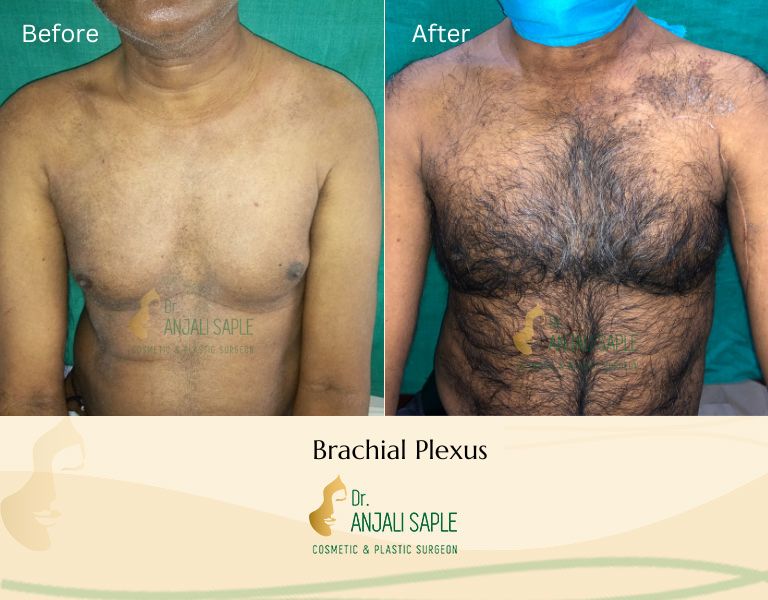Expert Care
Transform Your Life with Brachial Plexus Surgery
At Dr. Anjali Saple's practice, we specialize in personalized Brachial Plexus Surgery to restore your mobility and enhance your quality of life.
- Improved arm and hand function
- Pain relief and increased strength
- Enhanced independence
- Supportive recovery guidance
Excellent doctor. I was in a time crunch and she did the procedure within a week of the first consultation. She's very patient in answering all the questions. My family is so happy with her treatment and the results, that a couple of them are getting ready to have their own procedures done by her. Happy and grateful that I decided for Dr.Saple.
Find Your Solution
Struggling with limited arm mobility can be frustrating and impact your life significantly.
From everyday activities to your favorite hobbies, nerve injuries can limit your independence. The uncertainty and pain can leave you feeling hopeless.
Transformative Approach
Brachial Plexus Surgery with Dr. Anjali Saple
Dr. Anjali Saple specializes in Brachial Plexus Surgery, addressing complex nerve injuries that affect the upper limb. Her extensive experience over 25 years allows her to create tailored surgical solutions aimed at restoring function and alleviating discomfort. With a focus on patient-centered care, each treatment is designed uniquely to best address your specific injury and recovery goals.
Why Choose Us
Unmatched Expertise and Compassion
Dr. Saple's dedicated approach to patient care sets her apart, ensuring optimal outcomes for every patient.
Experienced Specialist
With 25+ years in plastic surgery, Dr. Saple has honed her skills in nerve repair and reconstruction.
Personalized Treatment Plans
Every surgery is complemented by tailored recovery plans to support your unique healing journey.
Comprehensive Support
Dr. Saple provides ongoing consultations and support post-surgery for your confident recovery.
FAQs
Brachial Plexus Surgery FAQs
It is a surgical procedure designed to repair nerve injuries affecting the upper limb.
A consultation with Dr. Saple will determine your eligibility based on your condition.
Recovery varies, but you will receive a tailored plan to guide you through it.
A certain level of discomfort is normal, but Dr. Saple will manage your pain effectively.
Each recovery timeline is individualized; a follow-up will help chart your progress.
Every surgical procedure carries risks, which will be discussed during your consultation.
Costs vary based on specific needs and recovery plans; Dr. Saple will provide an estimate.
Surgery is conducted at well-equipped hospitals across Vishakhapatnam.
Have More Questions?
Contact us today for any additional inquiries regarding Brachial Plexus Surgery.
Life-Changing Advantages
Key Benefits of Brachial Plexus Surgery
Enhanced Mobility
Regain functional movement in your arm and hand.
Reduced Pain
Experience significant pain relief following surgery.
Improved Quality of Life
Reclaim activities you love without limitations.
Personalized Aftercare
Receive custom recovery plans to ensure optimal healing.
Expert Guidance
Benefit from over 25 years of surgical experience.
Compassionate Care
Enjoy a supportive environment where your concerns are prioritized.
Patient Transformations
See the incredible results our patients have achieved.
What Our Patients Say
Read testimonials from patients who have successfully undergone Brachial Plexus Surgery and experienced life-changing results..
Easy Steps to Recovery
How to Begin Your Brachial Plexus Surgery Journey
Initial Consultation
Discuss your symptoms and concerns with Dr. Saple in a detailed consultation.
Personalized Treatment Plan
Receive a customized surgical plan specifically tailored to your needs.
Surgery and Recovery
Undergoing the surgery with expert guidance and following the tailored recovery strategy.
Addressing Concerns
We understand you may have fears or questions about surgery. Here are some clarifications:
We offer flexible pricing and payment plans to make surgery more accessible.
Every surgery has risks, which will be thoroughly explained during your consultation.
While many see significant improvement, outcomes depend on the injury’s nature.
Take your time to consider; we encourage asking questions to feel fully confident.
Still Unsure?
Let’s talk through your concerns together. Schedule your consultation now.
Take the First Step Today!
Empower Yourself with Expert Care from Dr. Anjali Saple.
Your Trusted Plastic Surgeon
Dr. Anjali Saple - Brachial Plexus Specialist
With unparalleled experience in plastic surgery, Dr. Saple is committed to restoring function and enhancing the quality of life for her patients.






